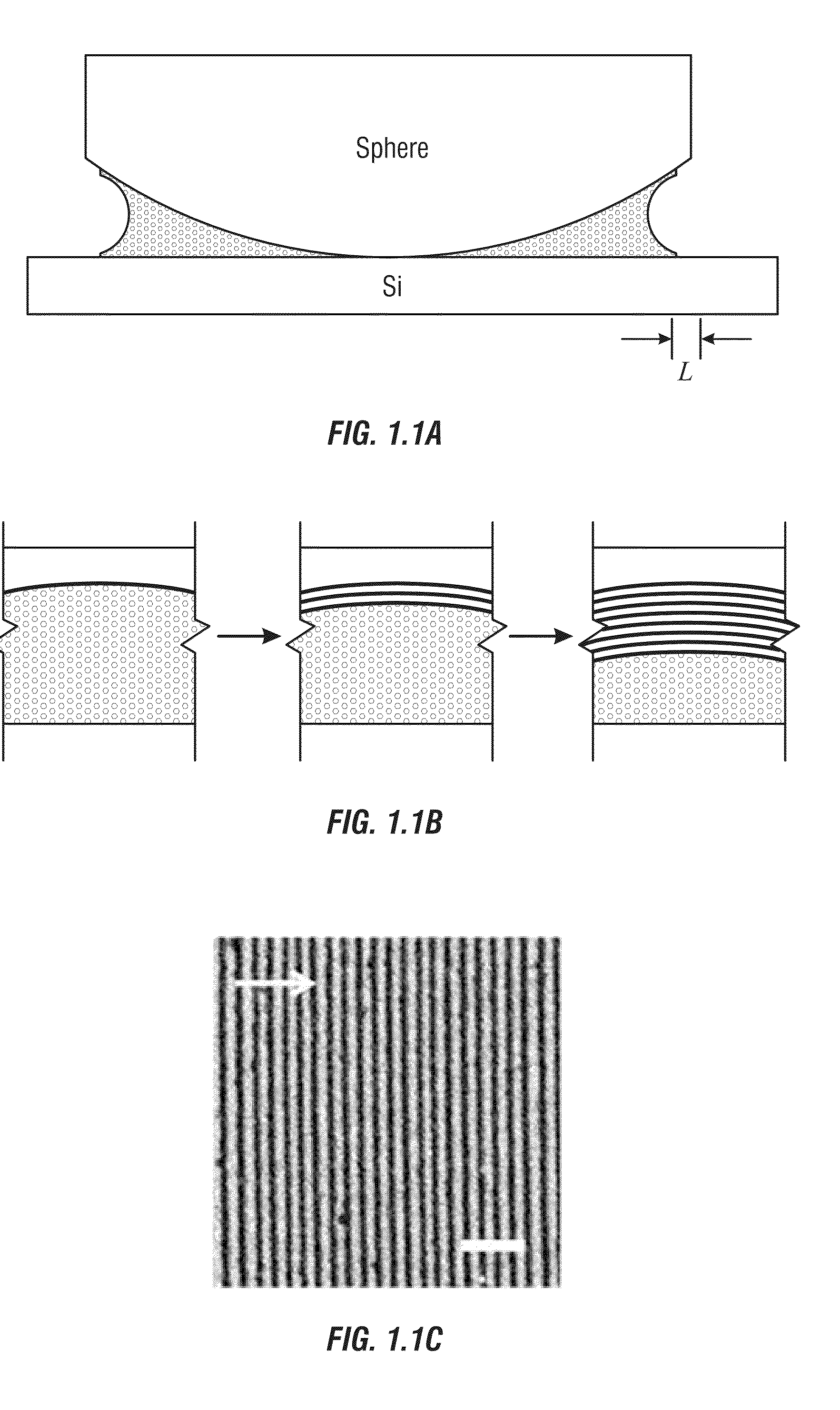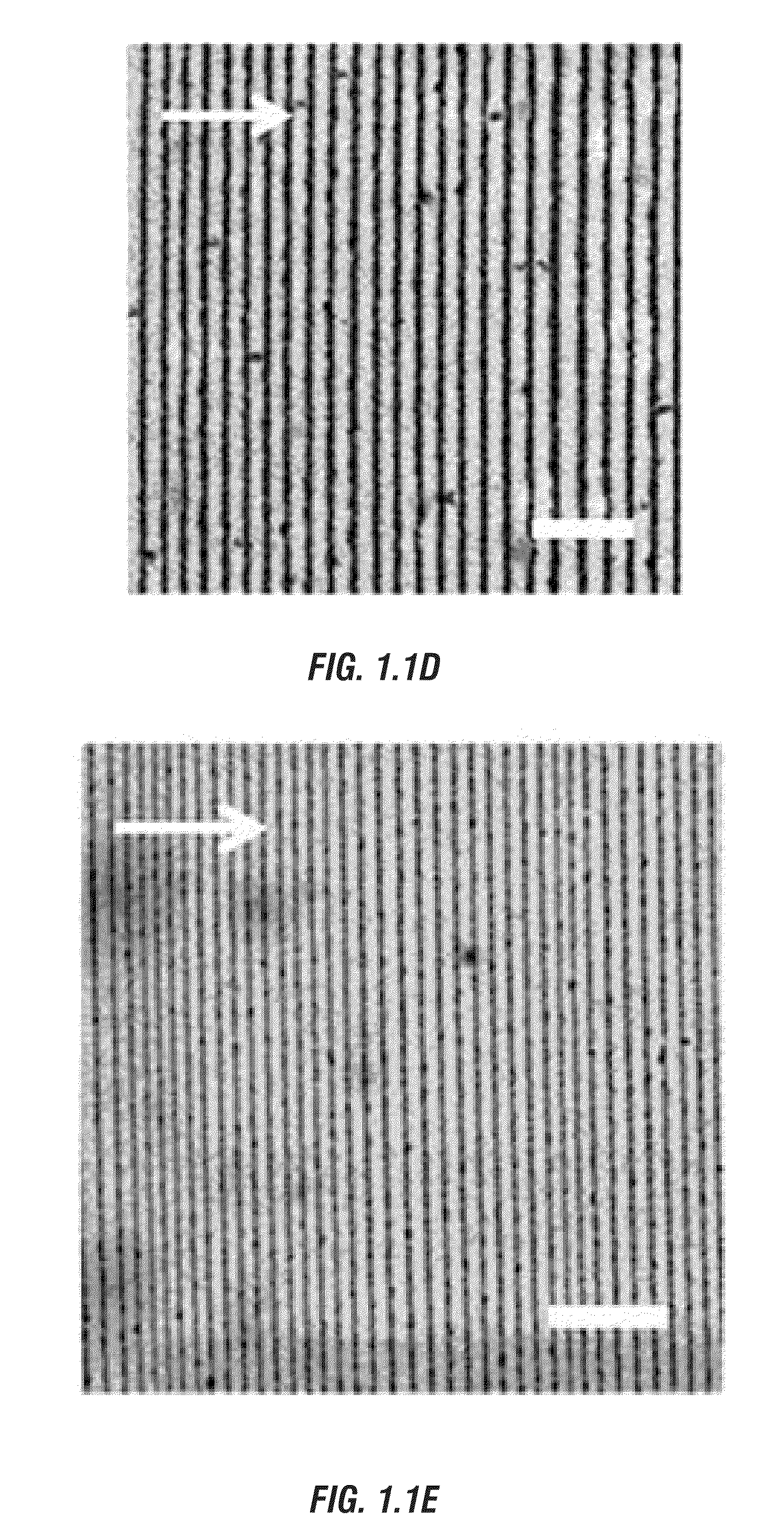Drying-mediated self-assembly of ordered or hierarchically ordered micro- and sub-micro scale structures and their uses as multifunctional materials
a micro- and sub-micro-scale structure and self-assembly technology, which is applied in the field of drying-mediated self-assembly of ordered or hierarchically ordered micro- and sub-micro-scale structures and their use as multi-functional materials, can solve the problems of difficult fabrication of such small-scale structures for useful functions, difficult to order structures at the micro- and sub-micro-scale, and present techniques tend to be complex and interactiv
- Summary
- Abstract
- Description
- Claims
- Application Information
AI Technical Summary
Benefits of technology
Problems solved by technology
Method used
Image
Examples
example 1
REFERENCES FOR EXAMPLE 1
[0067][1] G. M. Whitesides, B. Grzybowski, Science 2002, 295, 2418.[0068][2] T. Thurn-Albrecht, J. Schotter, C. A. Kastle, N. Emley, T. Shibauchi, L. Krusin-Elbaum, K. Guarini, B. C. T., M. T. Tuominen, T. P. Russell, Science 2000, 290,[0069][3] V. V. Tsukruk, H. Ko, S. Peleshanko, Phys. Rev. Lett. 2004, 92, 065502.[0070][4] H. Ko, V. V. Tsukruk, Nano Lett. 2006, 6, 1443.[0071][5] Y. Lin, A. Boker, J. He, K. Sill, H. Xiang, C. Abetz, X. Li, J. Wang, T. Emrick, S. Long, Q. Wang, A. Balazs, T. P. Russell, Nature 2005, 434, 55.[0072][6] M. Gleiche, L. F. Chi, H. Fuchs, Nature 2000, 403, 173.[0073][7] J. Huang, F. Kim, A. R. Tao, S. Connor, P. D. Yang, Nature Mater 2005, 4, 896.[0074][8] A. M. Kalsin, M. Fialkowski, M. Paszewski, S. K. Smoukov, K. J. M. Bishop, B. A. Grzybowski, Science 2006, 312, 420.[0075][9] R. D. Deegan, O. Bakajin, T. F. Dupont, G. Huber, S. R. Nagel, T. A. Witten, Nature 1997, 389, 827.[0076][10] R. D. Deegan, O. Bakajin, T. F. Dupont, G. H...
example 2
REFERENCES FOR EXAMPLE 2
[0125]1. Nguyen, V. X.; Stebe, K. J. Phys. Rev. Lett. 2002, 88, 164501.[0126]2. Bormashenko, E.; Pogreb, R.; Musin, A.; Stanevsky, O.; Bormashenko, Y.; Whyman, G.; Barkay, Z. J. Coll. Interface Sci. 2006, 300, 293.[0127]3. Bormashenko, E.; Pogreb, R.; Musin, A.; Stanevsky, O.; Bormashenko, Y.; Whyman, G.; Gendelman, O.; Barkay, Z. J. Coll. Interface Sci. 2006, 297, 534.[0128]4. de Gennes, P. G. Eur. Phys. J. E 2001, 6, 421.[0129]5. Karthaus, O.; Grasjo, L.; Maruyama, N.; Shimomura, M. Chaos 1999, 9, 308.[0130]6. Hu, H.; Larson, R. G. Langmuir 2005, 21, 3963.[0131]7. Cazabat, A. M.; Heslot, F.; Troian, S. M.; Carles, P. Nature 1990, 346, 824.[0132]8. Yabu, H.; Shimomura, M. Adv. Funct. Mater. 2005, 15, 575.[0133]9. Rabani, E.; Reichman, D. R.; Geissler, P. L.; Brus, L. E. Nature 2003, 426, 271.[0134]10. Lin, Z. Q.; Granick, S. J. Am. Chem. Soc. 2005, 127, 2816.[0135]11. Xu, J.; xia, J.; Hong, S. W.; Lin, Z. Q.; Qiu, F.; Yang, Y. L. Phys. Rev. Lett. 2006, 96, 0...
example 3
REFERENCES FOR EXAMPLE 3
[0172][1] Y. Lin, A. Boker, J. He, K. Sill, H. Xiang, C. Abetz, X. Li, J. Wang, T. Emrick, S. Long, Q. Wang, A. Balazs, T. P. Russell, Nature 2005, 434, 55.[0173][2] M. Gleiche, L. F. Chi, H. Fuchs, Nature 2000, 403, 173.[0174][3] J. Huang, F. Kim, A. R. Tao, S. Connor, P. D. Yang, Nature Mater 2005, 4, 896.[0175][4] R. D. Deegan, O. Bakajin, T. F. Dupont, G. Huber, S. R. Nagel, T. A. Witten, Nature 1997, 389, 827.[0176][5] R. D. Deegan, Phys. Rev. E 2000, 61, 475.[0177][6] R. D. Deegan, O. Bakajin, T. F. Dupont, G. Huber, S. R. Nagel, T. A. Witten, Phys. Rev. E 2000, 62, 756.[0178][7] O. Karthaus, L. Grasjo, N. Maruyama, M. Shimomura, Chaos 1999, 9, 308.[0179][8] E. Rabani, D. R. Reichman, P. L. Geissler, L. E. Brus, Nature 2003, 426, 271.[0180][9] Z. Mitov, E. Kumacheva, Phys. Rev. Lett. 1998, 81, 3427.[0181][10] E. Adachi, A. S. Dimitrov, K. Nagayama, Langmuir 1995, 11, 1057.[0182][11] L. Shmuylovich, A. Q. Shen, H. A. Stone, Langmuir 2002, 18, 3441.[0183]...
PUM
| Property | Measurement | Unit |
|---|---|---|
| diameter | aaaaa | aaaaa |
| diameter | aaaaa | aaaaa |
| width | aaaaa | aaaaa |
Abstract
Description
Claims
Application Information
 Login to View More
Login to View More - R&D
- Intellectual Property
- Life Sciences
- Materials
- Tech Scout
- Unparalleled Data Quality
- Higher Quality Content
- 60% Fewer Hallucinations
Browse by: Latest US Patents, China's latest patents, Technical Efficacy Thesaurus, Application Domain, Technology Topic, Popular Technical Reports.
© 2025 PatSnap. All rights reserved.Legal|Privacy policy|Modern Slavery Act Transparency Statement|Sitemap|About US| Contact US: help@patsnap.com



